Procurement and Supply Chain Analysis of Adidas Company
VerifiedAdded on 2023/06/03
|17
|4281
|127
AI Summary
This paper analyzes the procurement and supply chain of Adidas Company, discussing the findings associated with supply, information, integration, and sustainability issues. It also discusses improvement programs to achieve the company's vision and goals.
Contribute Materials
Your contribution can guide someone’s learning journey. Share your
documents today.
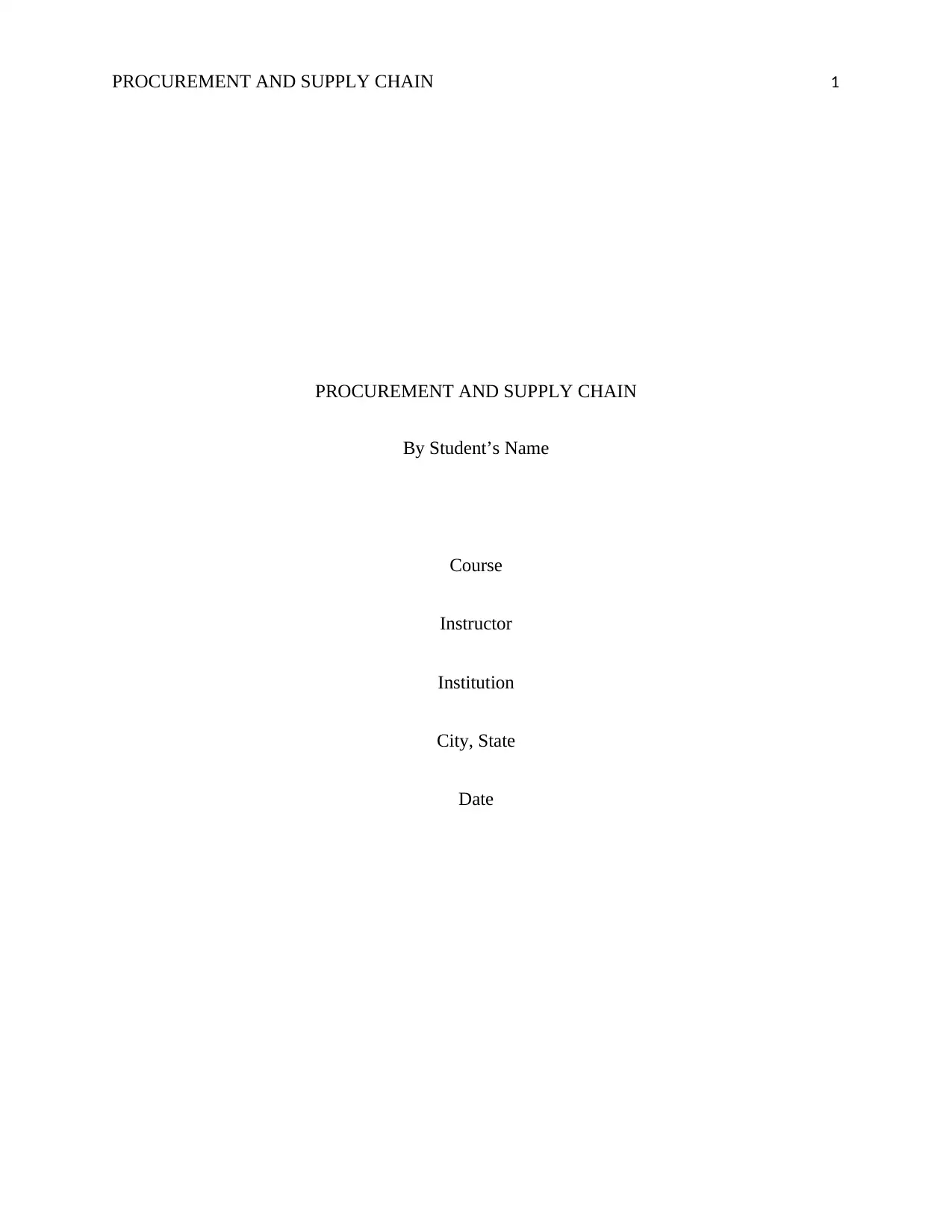
PROCUREMENT AND SUPPLY CHAIN 1
PROCUREMENT AND SUPPLY CHAIN
By Student’s Name
Course
Instructor
Institution
City, State
Date
PROCUREMENT AND SUPPLY CHAIN
By Student’s Name
Course
Instructor
Institution
City, State
Date
Secure Best Marks with AI Grader
Need help grading? Try our AI Grader for instant feedback on your assignments.
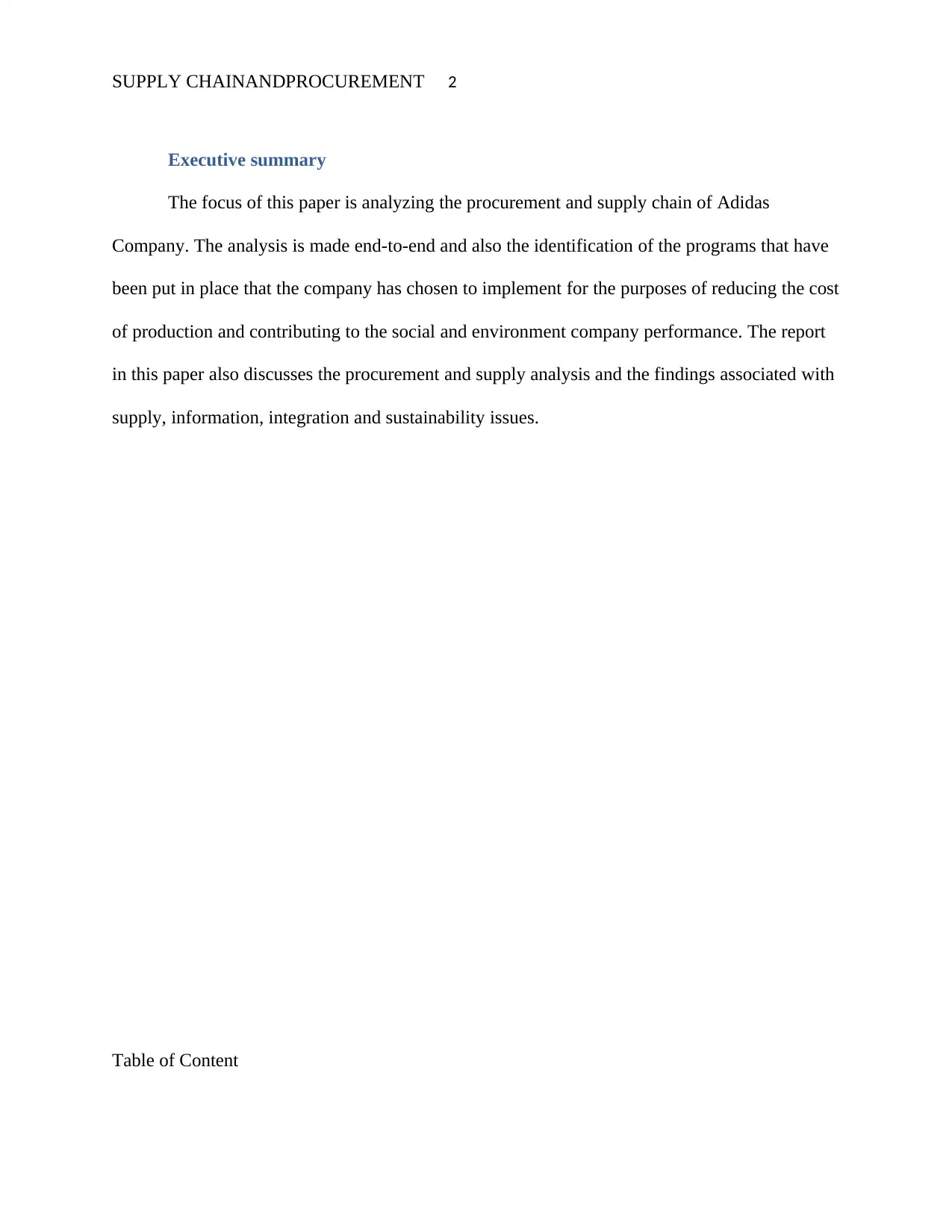
SUPPLY CHAINANDPROCUREMENT 2
Executive summary
The focus of this paper is analyzing the procurement and supply chain of Adidas
Company. The analysis is made end-to-end and also the identification of the programs that have
been put in place that the company has chosen to implement for the purposes of reducing the cost
of production and contributing to the social and environment company performance. The report
in this paper also discusses the procurement and supply analysis and the findings associated with
supply, information, integration and sustainability issues.
Table of Content
Executive summary
The focus of this paper is analyzing the procurement and supply chain of Adidas
Company. The analysis is made end-to-end and also the identification of the programs that have
been put in place that the company has chosen to implement for the purposes of reducing the cost
of production and contributing to the social and environment company performance. The report
in this paper also discusses the procurement and supply analysis and the findings associated with
supply, information, integration and sustainability issues.
Table of Content
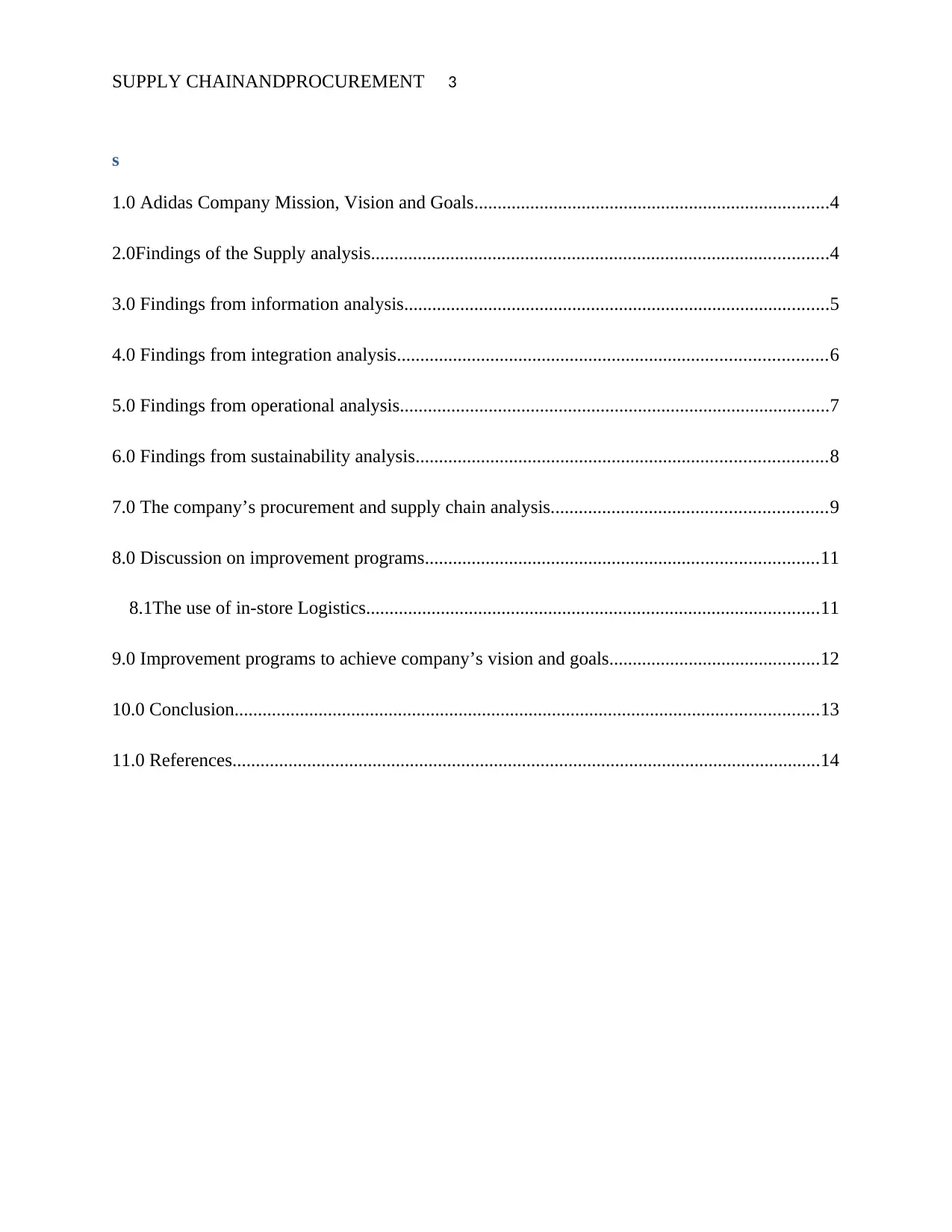
SUPPLY CHAINANDPROCUREMENT 3
s
1.0 Adidas Company Mission, Vision and Goals............................................................................4
2.0Findings of the Supply analysis..................................................................................................4
3.0 Findings from information analysis...........................................................................................5
4.0 Findings from integration analysis............................................................................................6
5.0 Findings from operational analysis............................................................................................7
6.0 Findings from sustainability analysis........................................................................................8
7.0 The company’s procurement and supply chain analysis...........................................................9
8.0 Discussion on improvement programs....................................................................................11
8.1The use of in-store Logistics.................................................................................................11
9.0 Improvement programs to achieve company’s vision and goals.............................................12
10.0 Conclusion.............................................................................................................................13
11.0 References..............................................................................................................................14
s
1.0 Adidas Company Mission, Vision and Goals............................................................................4
2.0Findings of the Supply analysis..................................................................................................4
3.0 Findings from information analysis...........................................................................................5
4.0 Findings from integration analysis............................................................................................6
5.0 Findings from operational analysis............................................................................................7
6.0 Findings from sustainability analysis........................................................................................8
7.0 The company’s procurement and supply chain analysis...........................................................9
8.0 Discussion on improvement programs....................................................................................11
8.1The use of in-store Logistics.................................................................................................11
9.0 Improvement programs to achieve company’s vision and goals.............................................12
10.0 Conclusion.............................................................................................................................13
11.0 References..............................................................................................................................14
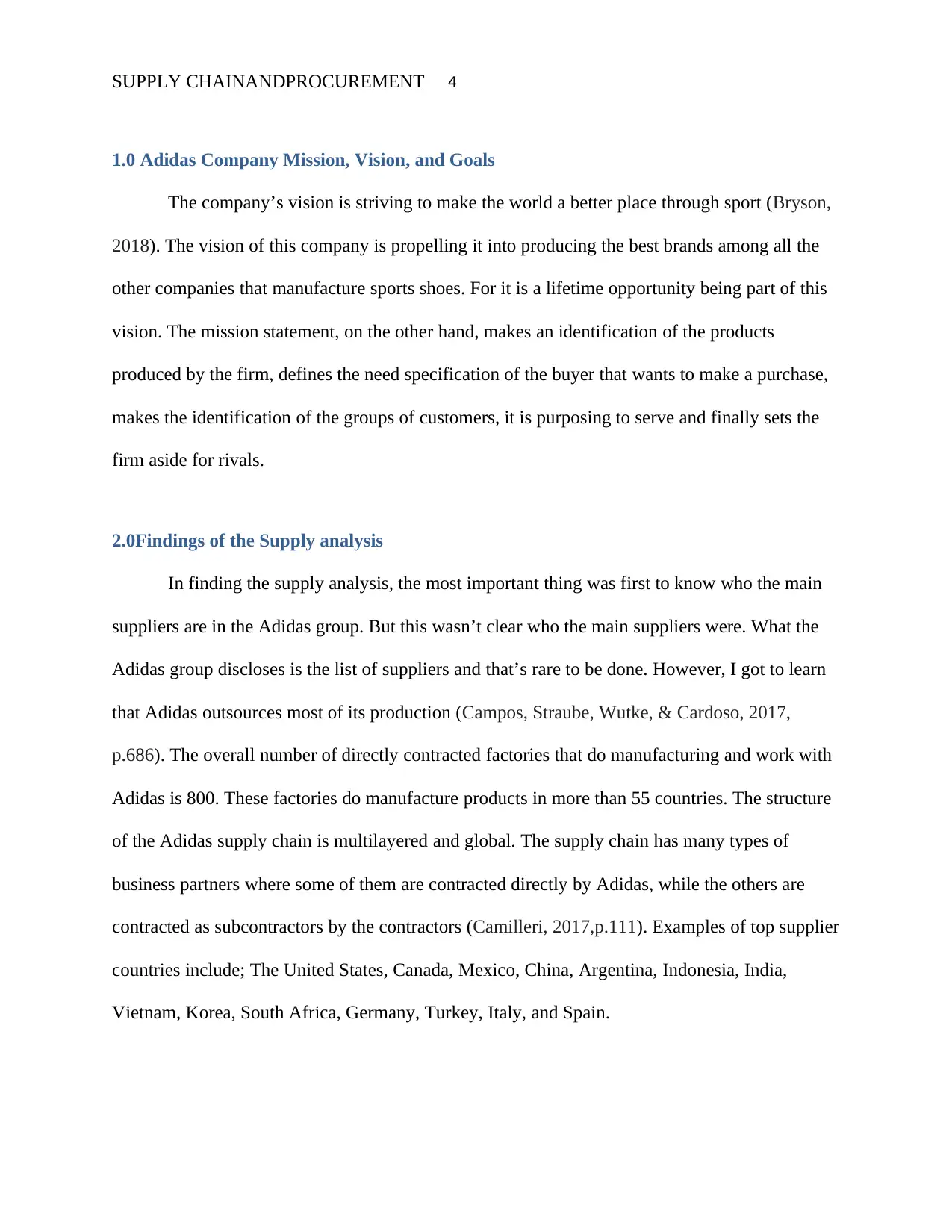
SUPPLY CHAINANDPROCUREMENT 4
1.0 Adidas Company Mission, Vision, and Goals
The company’s vision is striving to make the world a better place through sport (Bryson,
2018). The vision of this company is propelling it into producing the best brands among all the
other companies that manufacture sports shoes. For it is a lifetime opportunity being part of this
vision. The mission statement, on the other hand, makes an identification of the products
produced by the firm, defines the need specification of the buyer that wants to make a purchase,
makes the identification of the groups of customers, it is purposing to serve and finally sets the
firm aside for rivals.
2.0Findings of the Supply analysis
In finding the supply analysis, the most important thing was first to know who the main
suppliers are in the Adidas group. But this wasn’t clear who the main suppliers were. What the
Adidas group discloses is the list of suppliers and that’s rare to be done. However, I got to learn
that Adidas outsources most of its production (Campos, Straube, Wutke, & Cardoso, 2017,
p.686). The overall number of directly contracted factories that do manufacturing and work with
Adidas is 800. These factories do manufacture products in more than 55 countries. The structure
of the Adidas supply chain is multilayered and global. The supply chain has many types of
business partners where some of them are contracted directly by Adidas, while the others are
contracted as subcontractors by the contractors (Camilleri, 2017,p.111). Examples of top supplier
countries include; The United States, Canada, Mexico, China, Argentina, Indonesia, India,
Vietnam, Korea, South Africa, Germany, Turkey, Italy, and Spain.
1.0 Adidas Company Mission, Vision, and Goals
The company’s vision is striving to make the world a better place through sport (Bryson,
2018). The vision of this company is propelling it into producing the best brands among all the
other companies that manufacture sports shoes. For it is a lifetime opportunity being part of this
vision. The mission statement, on the other hand, makes an identification of the products
produced by the firm, defines the need specification of the buyer that wants to make a purchase,
makes the identification of the groups of customers, it is purposing to serve and finally sets the
firm aside for rivals.
2.0Findings of the Supply analysis
In finding the supply analysis, the most important thing was first to know who the main
suppliers are in the Adidas group. But this wasn’t clear who the main suppliers were. What the
Adidas group discloses is the list of suppliers and that’s rare to be done. However, I got to learn
that Adidas outsources most of its production (Campos, Straube, Wutke, & Cardoso, 2017,
p.686). The overall number of directly contracted factories that do manufacturing and work with
Adidas is 800. These factories do manufacture products in more than 55 countries. The structure
of the Adidas supply chain is multilayered and global. The supply chain has many types of
business partners where some of them are contracted directly by Adidas, while the others are
contracted as subcontractors by the contractors (Camilleri, 2017,p.111). Examples of top supplier
countries include; The United States, Canada, Mexico, China, Argentina, Indonesia, India,
Vietnam, Korea, South Africa, Germany, Turkey, Italy, and Spain.
Secure Best Marks with AI Grader
Need help grading? Try our AI Grader for instant feedback on your assignments.
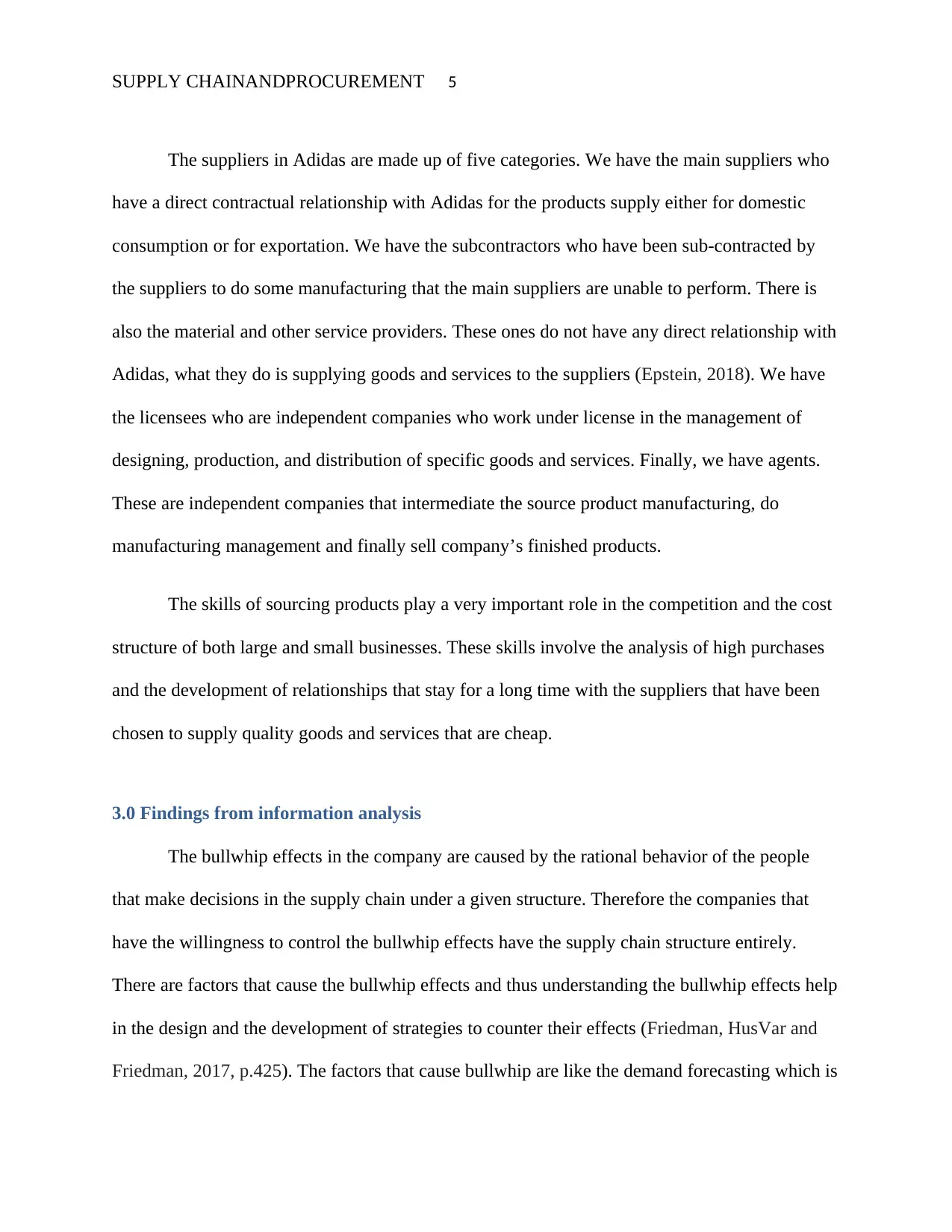
SUPPLY CHAINANDPROCUREMENT 5
The suppliers in Adidas are made up of five categories. We have the main suppliers who
have a direct contractual relationship with Adidas for the products supply either for domestic
consumption or for exportation. We have the subcontractors who have been sub-contracted by
the suppliers to do some manufacturing that the main suppliers are unable to perform. There is
also the material and other service providers. These ones do not have any direct relationship with
Adidas, what they do is supplying goods and services to the suppliers (Epstein, 2018). We have
the licensees who are independent companies who work under license in the management of
designing, production, and distribution of specific goods and services. Finally, we have agents.
These are independent companies that intermediate the source product manufacturing, do
manufacturing management and finally sell company’s finished products.
The skills of sourcing products play a very important role in the competition and the cost
structure of both large and small businesses. These skills involve the analysis of high purchases
and the development of relationships that stay for a long time with the suppliers that have been
chosen to supply quality goods and services that are cheap.
3.0 Findings from information analysis
The bullwhip effects in the company are caused by the rational behavior of the people
that make decisions in the supply chain under a given structure. Therefore the companies that
have the willingness to control the bullwhip effects have the supply chain structure entirely.
There are factors that cause the bullwhip effects and thus understanding the bullwhip effects help
in the design and the development of strategies to counter their effects (Friedman, HusVar and
Friedman, 2017, p.425). The factors that cause bullwhip are like the demand forecasting which is
The suppliers in Adidas are made up of five categories. We have the main suppliers who
have a direct contractual relationship with Adidas for the products supply either for domestic
consumption or for exportation. We have the subcontractors who have been sub-contracted by
the suppliers to do some manufacturing that the main suppliers are unable to perform. There is
also the material and other service providers. These ones do not have any direct relationship with
Adidas, what they do is supplying goods and services to the suppliers (Epstein, 2018). We have
the licensees who are independent companies who work under license in the management of
designing, production, and distribution of specific goods and services. Finally, we have agents.
These are independent companies that intermediate the source product manufacturing, do
manufacturing management and finally sell company’s finished products.
The skills of sourcing products play a very important role in the competition and the cost
structure of both large and small businesses. These skills involve the analysis of high purchases
and the development of relationships that stay for a long time with the suppliers that have been
chosen to supply quality goods and services that are cheap.
3.0 Findings from information analysis
The bullwhip effects in the company are caused by the rational behavior of the people
that make decisions in the supply chain under a given structure. Therefore the companies that
have the willingness to control the bullwhip effects have the supply chain structure entirely.
There are factors that cause the bullwhip effects and thus understanding the bullwhip effects help
in the design and the development of strategies to counter their effects (Friedman, HusVar and
Friedman, 2017, p.425). The factors that cause bullwhip are like the demand forecasting which is
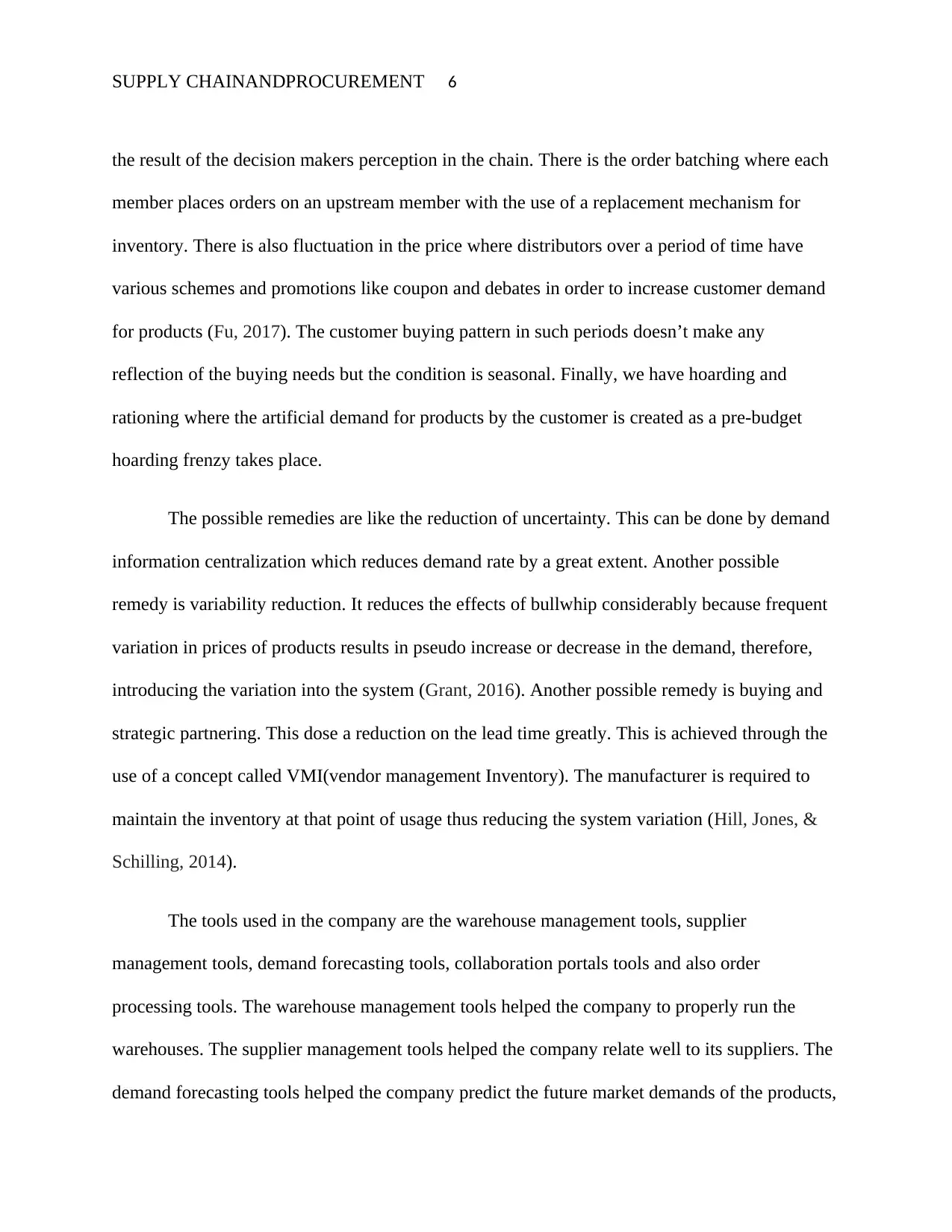
SUPPLY CHAINANDPROCUREMENT 6
the result of the decision makers perception in the chain. There is the order batching where each
member places orders on an upstream member with the use of a replacement mechanism for
inventory. There is also fluctuation in the price where distributors over a period of time have
various schemes and promotions like coupon and debates in order to increase customer demand
for products (Fu, 2017). The customer buying pattern in such periods doesn’t make any
reflection of the buying needs but the condition is seasonal. Finally, we have hoarding and
rationing where the artificial demand for products by the customer is created as a pre-budget
hoarding frenzy takes place.
The possible remedies are like the reduction of uncertainty. This can be done by demand
information centralization which reduces demand rate by a great extent. Another possible
remedy is variability reduction. It reduces the effects of bullwhip considerably because frequent
variation in prices of products results in pseudo increase or decrease in the demand, therefore,
introducing the variation into the system (Grant, 2016). Another possible remedy is buying and
strategic partnering. This dose a reduction on the lead time greatly. This is achieved through the
use of a concept called VMI(vendor management Inventory). The manufacturer is required to
maintain the inventory at that point of usage thus reducing the system variation (Hill, Jones, &
Schilling, 2014).
The tools used in the company are the warehouse management tools, supplier
management tools, demand forecasting tools, collaboration portals tools and also order
processing tools. The warehouse management tools helped the company to properly run the
warehouses. The supplier management tools helped the company relate well to its suppliers. The
demand forecasting tools helped the company predict the future market demands of the products,
the result of the decision makers perception in the chain. There is the order batching where each
member places orders on an upstream member with the use of a replacement mechanism for
inventory. There is also fluctuation in the price where distributors over a period of time have
various schemes and promotions like coupon and debates in order to increase customer demand
for products (Fu, 2017). The customer buying pattern in such periods doesn’t make any
reflection of the buying needs but the condition is seasonal. Finally, we have hoarding and
rationing where the artificial demand for products by the customer is created as a pre-budget
hoarding frenzy takes place.
The possible remedies are like the reduction of uncertainty. This can be done by demand
information centralization which reduces demand rate by a great extent. Another possible
remedy is variability reduction. It reduces the effects of bullwhip considerably because frequent
variation in prices of products results in pseudo increase or decrease in the demand, therefore,
introducing the variation into the system (Grant, 2016). Another possible remedy is buying and
strategic partnering. This dose a reduction on the lead time greatly. This is achieved through the
use of a concept called VMI(vendor management Inventory). The manufacturer is required to
maintain the inventory at that point of usage thus reducing the system variation (Hill, Jones, &
Schilling, 2014).
The tools used in the company are the warehouse management tools, supplier
management tools, demand forecasting tools, collaboration portals tools and also order
processing tools. The warehouse management tools helped the company to properly run the
warehouses. The supplier management tools helped the company relate well to its suppliers. The
demand forecasting tools helped the company predict the future market demands of the products,
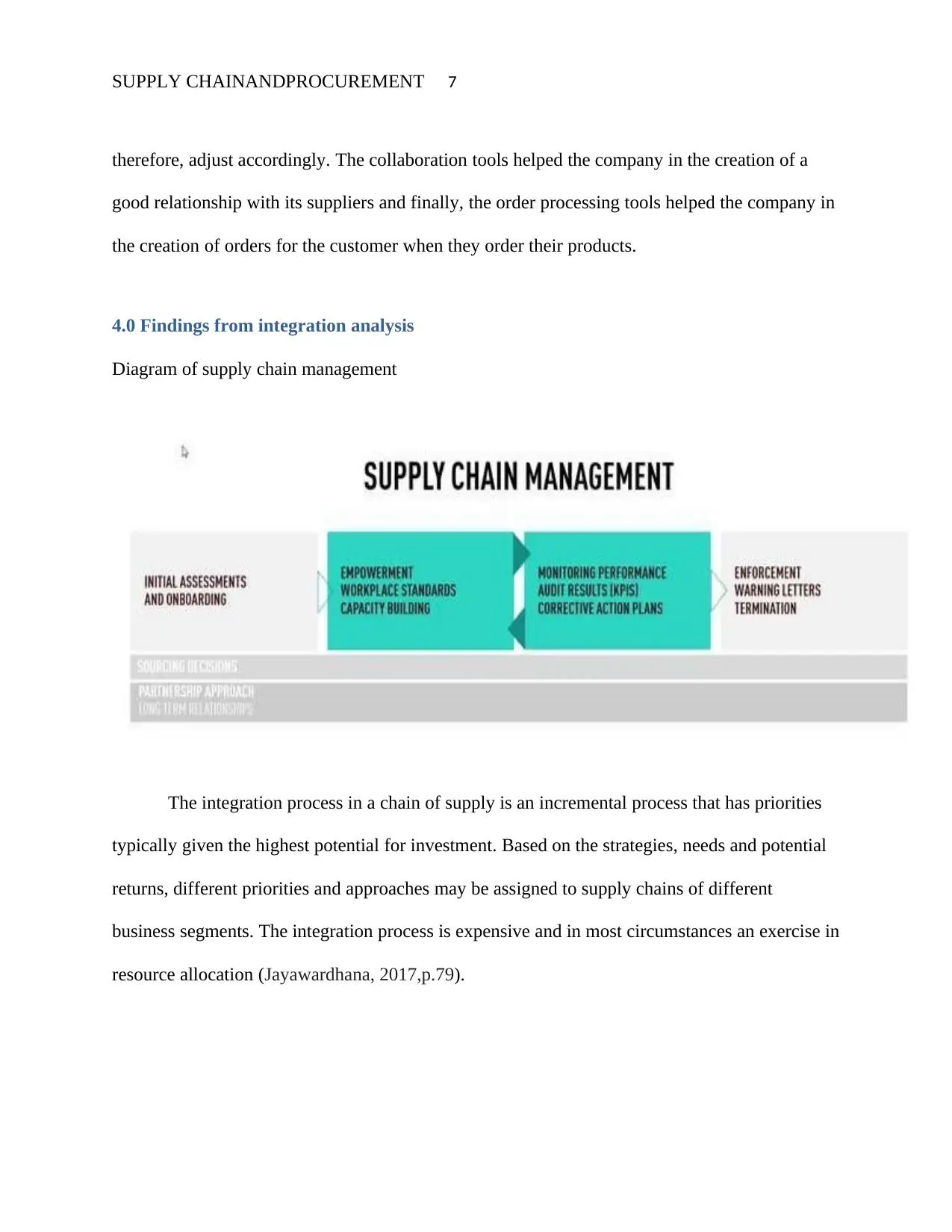
SUPPLY CHAINANDPROCUREMENT 7
therefore, adjust accordingly. The collaboration tools helped the company in the creation of a
good relationship with its suppliers and finally, the order processing tools helped the company in
the creation of orders for the customer when they order their products.
4.0 Findings from integration analysis
Diagram of supply chain management
The integration process in a chain of supply is an incremental process that has priorities
typically given the highest potential for investment. Based on the strategies, needs and potential
returns, different priorities and approaches may be assigned to supply chains of different
business segments. The integration process is expensive and in most circumstances an exercise in
resource allocation (Jayawardhana, 2017,p.79).
therefore, adjust accordingly. The collaboration tools helped the company in the creation of a
good relationship with its suppliers and finally, the order processing tools helped the company in
the creation of orders for the customer when they order their products.
4.0 Findings from integration analysis
Diagram of supply chain management
The integration process in a chain of supply is an incremental process that has priorities
typically given the highest potential for investment. Based on the strategies, needs and potential
returns, different priorities and approaches may be assigned to supply chains of different
business segments. The integration process is expensive and in most circumstances an exercise in
resource allocation (Jayawardhana, 2017,p.79).
Paraphrase This Document
Need a fresh take? Get an instant paraphrase of this document with our AI Paraphraser
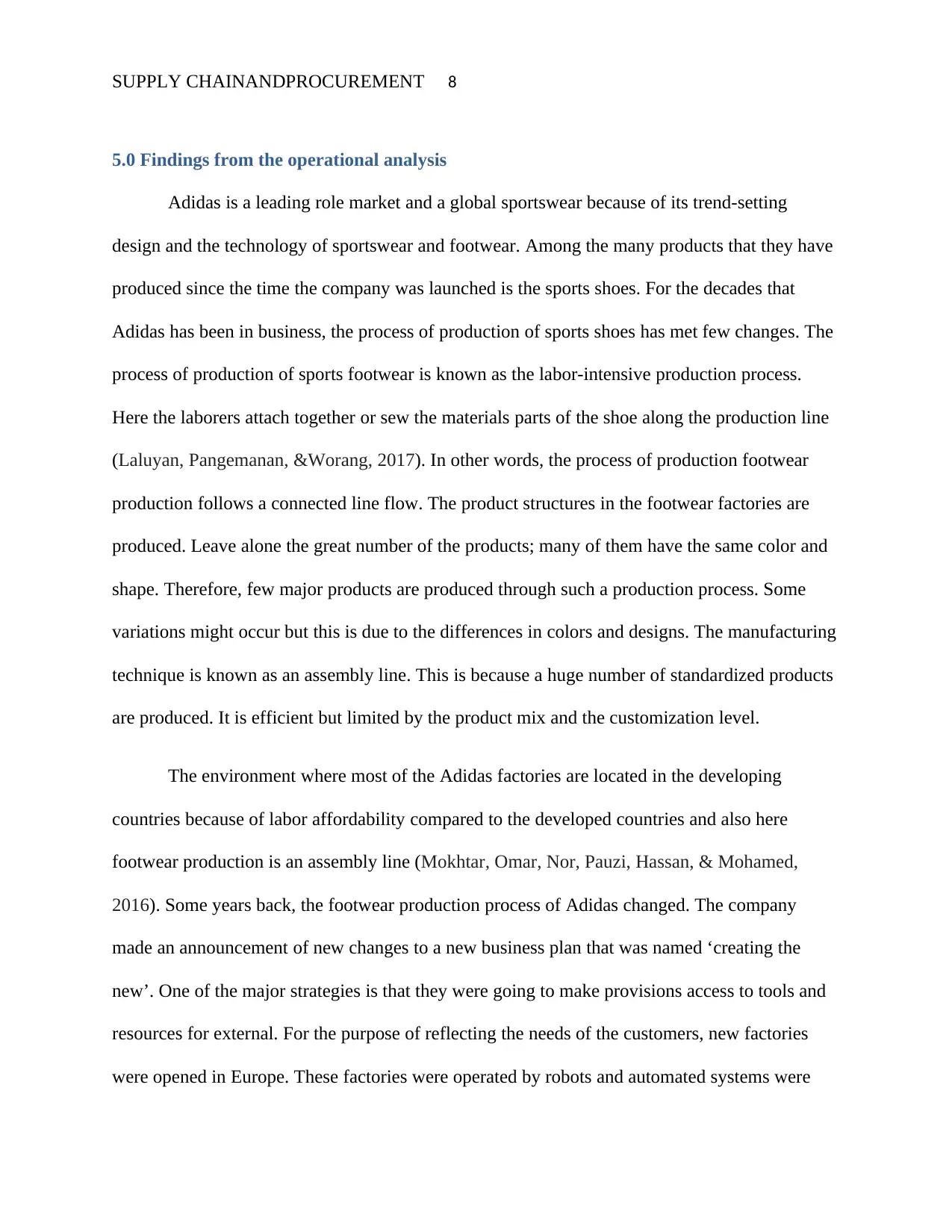
SUPPLY CHAINANDPROCUREMENT 8
5.0 Findings from the operational analysis
Adidas is a leading role market and a global sportswear because of its trend-setting
design and the technology of sportswear and footwear. Among the many products that they have
produced since the time the company was launched is the sports shoes. For the decades that
Adidas has been in business, the process of production of sports shoes has met few changes. The
process of production of sports footwear is known as the labor-intensive production process.
Here the laborers attach together or sew the materials parts of the shoe along the production line
(Laluyan, Pangemanan, &Worang, 2017). In other words, the process of production footwear
production follows a connected line flow. The product structures in the footwear factories are
produced. Leave alone the great number of the products; many of them have the same color and
shape. Therefore, few major products are produced through such a production process. Some
variations might occur but this is due to the differences in colors and designs. The manufacturing
technique is known as an assembly line. This is because a huge number of standardized products
are produced. It is efficient but limited by the product mix and the customization level.
The environment where most of the Adidas factories are located in the developing
countries because of labor affordability compared to the developed countries and also here
footwear production is an assembly line (Mokhtar, Omar, Nor, Pauzi, Hassan, & Mohamed,
2016). Some years back, the footwear production process of Adidas changed. The company
made an announcement of new changes to a new business plan that was named ‘creating the
new’. One of the major strategies is that they were going to make provisions access to tools and
resources for external. For the purpose of reflecting the needs of the customers, new factories
were opened in Europe. These factories were operated by robots and automated systems were
5.0 Findings from the operational analysis
Adidas is a leading role market and a global sportswear because of its trend-setting
design and the technology of sportswear and footwear. Among the many products that they have
produced since the time the company was launched is the sports shoes. For the decades that
Adidas has been in business, the process of production of sports shoes has met few changes. The
process of production of sports footwear is known as the labor-intensive production process.
Here the laborers attach together or sew the materials parts of the shoe along the production line
(Laluyan, Pangemanan, &Worang, 2017). In other words, the process of production footwear
production follows a connected line flow. The product structures in the footwear factories are
produced. Leave alone the great number of the products; many of them have the same color and
shape. Therefore, few major products are produced through such a production process. Some
variations might occur but this is due to the differences in colors and designs. The manufacturing
technique is known as an assembly line. This is because a huge number of standardized products
are produced. It is efficient but limited by the product mix and the customization level.
The environment where most of the Adidas factories are located in the developing
countries because of labor affordability compared to the developed countries and also here
footwear production is an assembly line (Mokhtar, Omar, Nor, Pauzi, Hassan, & Mohamed,
2016). Some years back, the footwear production process of Adidas changed. The company
made an announcement of new changes to a new business plan that was named ‘creating the
new’. One of the major strategies is that they were going to make provisions access to tools and
resources for external. For the purpose of reflecting the needs of the customers, new factories
were opened in Europe. These factories were operated by robots and automated systems were
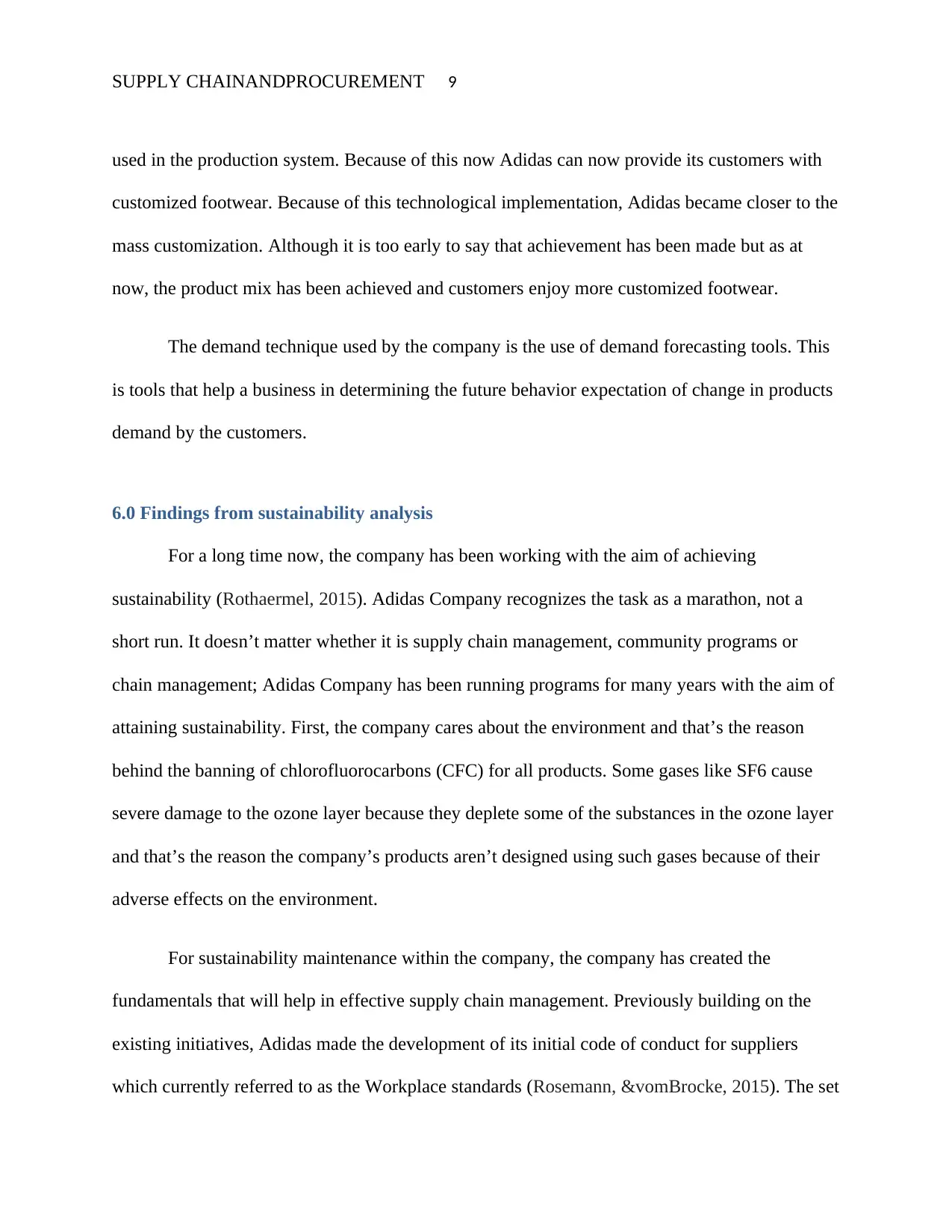
SUPPLY CHAINANDPROCUREMENT 9
used in the production system. Because of this now Adidas can now provide its customers with
customized footwear. Because of this technological implementation, Adidas became closer to the
mass customization. Although it is too early to say that achievement has been made but as at
now, the product mix has been achieved and customers enjoy more customized footwear.
The demand technique used by the company is the use of demand forecasting tools. This
is tools that help a business in determining the future behavior expectation of change in products
demand by the customers.
6.0 Findings from sustainability analysis
For a long time now, the company has been working with the aim of achieving
sustainability (Rothaermel, 2015). Adidas Company recognizes the task as a marathon, not a
short run. It doesn’t matter whether it is supply chain management, community programs or
chain management; Adidas Company has been running programs for many years with the aim of
attaining sustainability. First, the company cares about the environment and that’s the reason
behind the banning of chlorofluorocarbons (CFC) for all products. Some gases like SF6 cause
severe damage to the ozone layer because they deplete some of the substances in the ozone layer
and that’s the reason the company’s products aren’t designed using such gases because of their
adverse effects on the environment.
For sustainability maintenance within the company, the company has created the
fundamentals that will help in effective supply chain management. Previously building on the
existing initiatives, Adidas made the development of its initial code of conduct for suppliers
which currently referred to as the Workplace standards (Rosemann, &vomBrocke, 2015). The set
used in the production system. Because of this now Adidas can now provide its customers with
customized footwear. Because of this technological implementation, Adidas became closer to the
mass customization. Although it is too early to say that achievement has been made but as at
now, the product mix has been achieved and customers enjoy more customized footwear.
The demand technique used by the company is the use of demand forecasting tools. This
is tools that help a business in determining the future behavior expectation of change in products
demand by the customers.
6.0 Findings from sustainability analysis
For a long time now, the company has been working with the aim of achieving
sustainability (Rothaermel, 2015). Adidas Company recognizes the task as a marathon, not a
short run. It doesn’t matter whether it is supply chain management, community programs or
chain management; Adidas Company has been running programs for many years with the aim of
attaining sustainability. First, the company cares about the environment and that’s the reason
behind the banning of chlorofluorocarbons (CFC) for all products. Some gases like SF6 cause
severe damage to the ozone layer because they deplete some of the substances in the ozone layer
and that’s the reason the company’s products aren’t designed using such gases because of their
adverse effects on the environment.
For sustainability maintenance within the company, the company has created the
fundamentals that will help in effective supply chain management. Previously building on the
existing initiatives, Adidas made the development of its initial code of conduct for suppliers
which currently referred to as the Workplace standards (Rosemann, &vomBrocke, 2015). The set
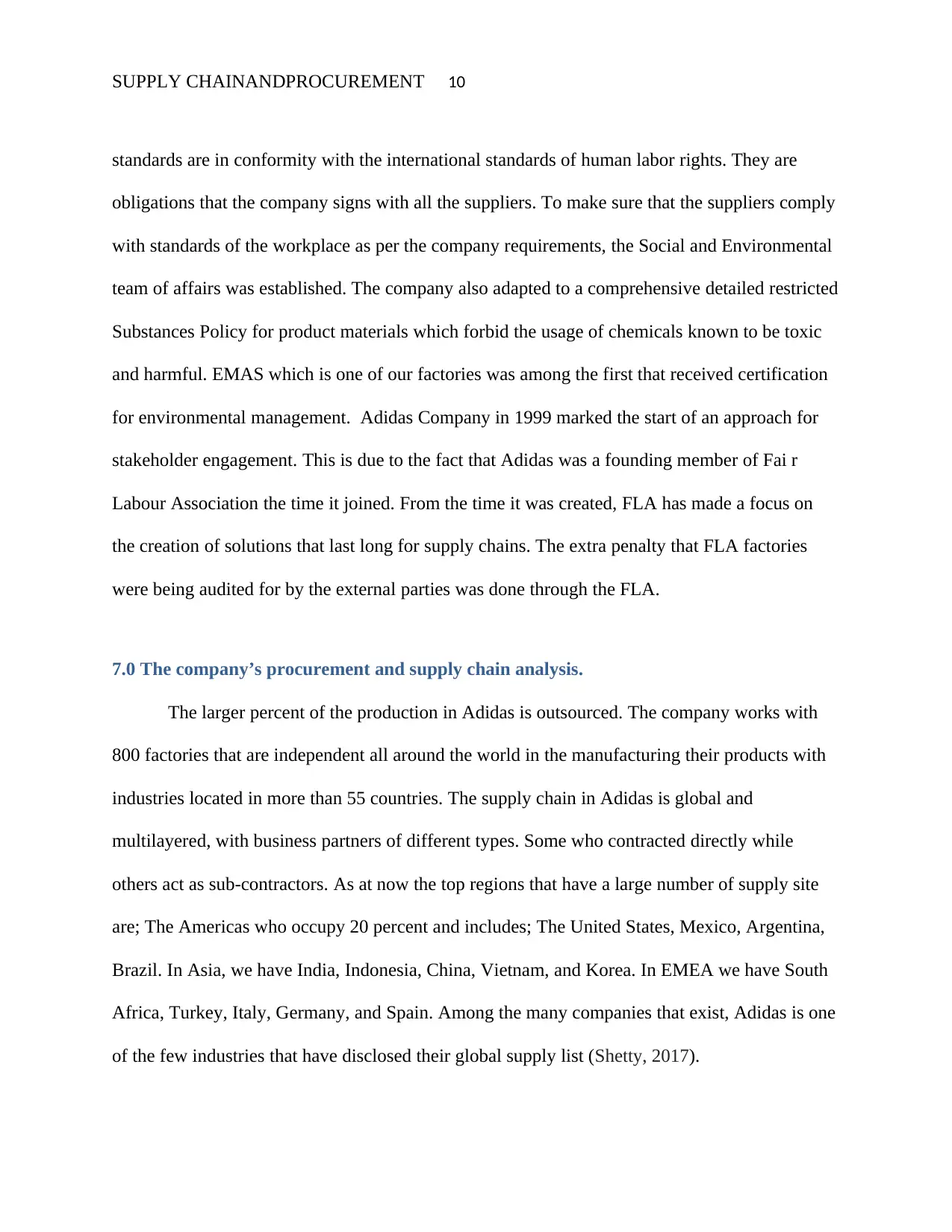
SUPPLY CHAINANDPROCUREMENT 10
standards are in conformity with the international standards of human labor rights. They are
obligations that the company signs with all the suppliers. To make sure that the suppliers comply
with standards of the workplace as per the company requirements, the Social and Environmental
team of affairs was established. The company also adapted to a comprehensive detailed restricted
Substances Policy for product materials which forbid the usage of chemicals known to be toxic
and harmful. EMAS which is one of our factories was among the first that received certification
for environmental management. Adidas Company in 1999 marked the start of an approach for
stakeholder engagement. This is due to the fact that Adidas was a founding member of Fai r
Labour Association the time it joined. From the time it was created, FLA has made a focus on
the creation of solutions that last long for supply chains. The extra penalty that FLA factories
were being audited for by the external parties was done through the FLA.
7.0 The company’s procurement and supply chain analysis.
The larger percent of the production in Adidas is outsourced. The company works with
800 factories that are independent all around the world in the manufacturing their products with
industries located in more than 55 countries. The supply chain in Adidas is global and
multilayered, with business partners of different types. Some who contracted directly while
others act as sub-contractors. As at now the top regions that have a large number of supply site
are; The Americas who occupy 20 percent and includes; The United States, Mexico, Argentina,
Brazil. In Asia, we have India, Indonesia, China, Vietnam, and Korea. In EMEA we have South
Africa, Turkey, Italy, Germany, and Spain. Among the many companies that exist, Adidas is one
of the few industries that have disclosed their global supply list (Shetty, 2017).
standards are in conformity with the international standards of human labor rights. They are
obligations that the company signs with all the suppliers. To make sure that the suppliers comply
with standards of the workplace as per the company requirements, the Social and Environmental
team of affairs was established. The company also adapted to a comprehensive detailed restricted
Substances Policy for product materials which forbid the usage of chemicals known to be toxic
and harmful. EMAS which is one of our factories was among the first that received certification
for environmental management. Adidas Company in 1999 marked the start of an approach for
stakeholder engagement. This is due to the fact that Adidas was a founding member of Fai r
Labour Association the time it joined. From the time it was created, FLA has made a focus on
the creation of solutions that last long for supply chains. The extra penalty that FLA factories
were being audited for by the external parties was done through the FLA.
7.0 The company’s procurement and supply chain analysis.
The larger percent of the production in Adidas is outsourced. The company works with
800 factories that are independent all around the world in the manufacturing their products with
industries located in more than 55 countries. The supply chain in Adidas is global and
multilayered, with business partners of different types. Some who contracted directly while
others act as sub-contractors. As at now the top regions that have a large number of supply site
are; The Americas who occupy 20 percent and includes; The United States, Mexico, Argentina,
Brazil. In Asia, we have India, Indonesia, China, Vietnam, and Korea. In EMEA we have South
Africa, Turkey, Italy, Germany, and Spain. Among the many companies that exist, Adidas is one
of the few industries that have disclosed their global supply list (Shetty, 2017).
Secure Best Marks with AI Grader
Need help grading? Try our AI Grader for instant feedback on your assignments.
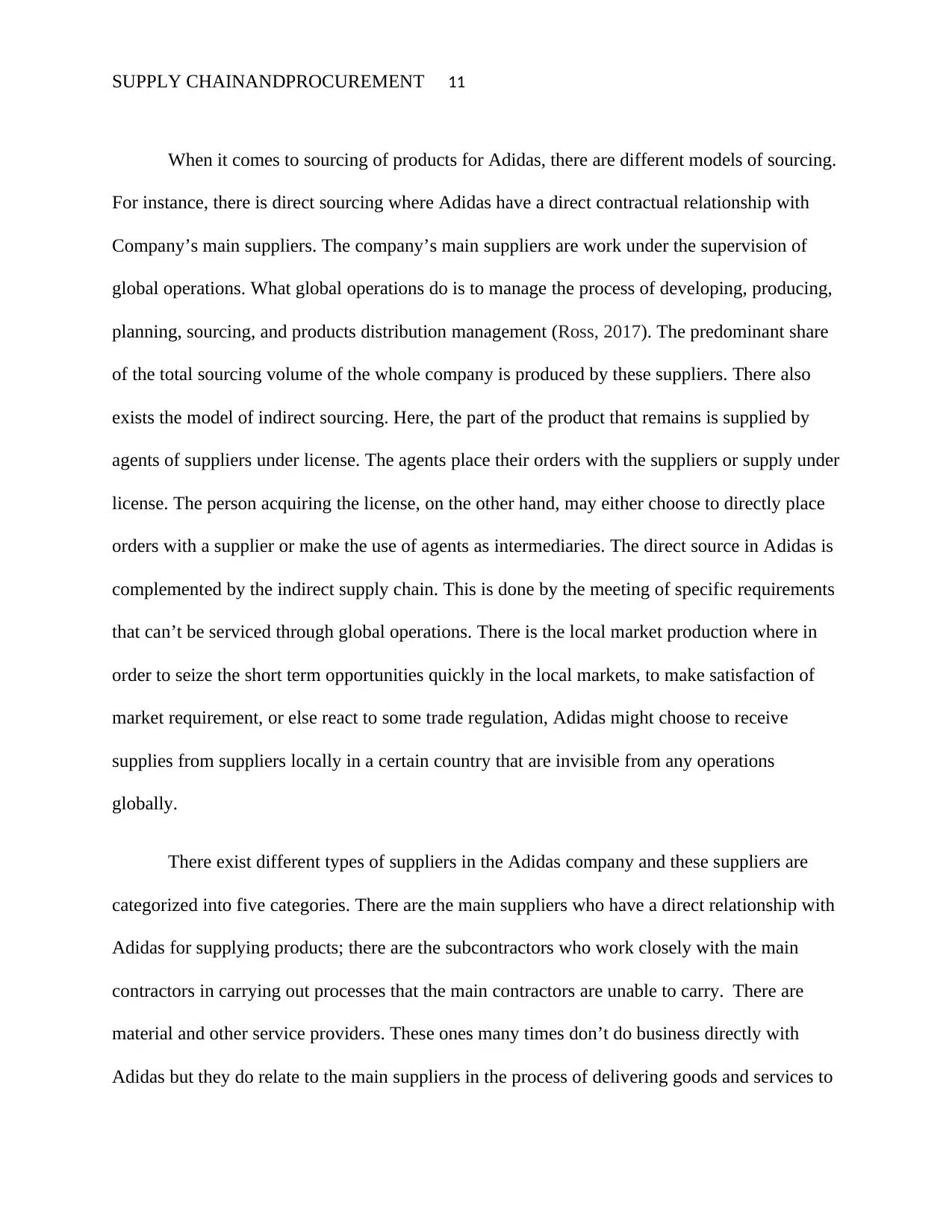
SUPPLY CHAINANDPROCUREMENT 11
When it comes to sourcing of products for Adidas, there are different models of sourcing.
For instance, there is direct sourcing where Adidas have a direct contractual relationship with
Company’s main suppliers. The company’s main suppliers are work under the supervision of
global operations. What global operations do is to manage the process of developing, producing,
planning, sourcing, and products distribution management (Ross, 2017). The predominant share
of the total sourcing volume of the whole company is produced by these suppliers. There also
exists the model of indirect sourcing. Here, the part of the product that remains is supplied by
agents of suppliers under license. The agents place their orders with the suppliers or supply under
license. The person acquiring the license, on the other hand, may either choose to directly place
orders with a supplier or make the use of agents as intermediaries. The direct source in Adidas is
complemented by the indirect supply chain. This is done by the meeting of specific requirements
that can’t be serviced through global operations. There is the local market production where in
order to seize the short term opportunities quickly in the local markets, to make satisfaction of
market requirement, or else react to some trade regulation, Adidas might choose to receive
supplies from suppliers locally in a certain country that are invisible from any operations
globally.
There exist different types of suppliers in the Adidas company and these suppliers are
categorized into five categories. There are the main suppliers who have a direct relationship with
Adidas for supplying products; there are the subcontractors who work closely with the main
contractors in carrying out processes that the main contractors are unable to carry. There are
material and other service providers. These ones many times don’t do business directly with
Adidas but they do relate to the main suppliers in the process of delivering goods and services to
When it comes to sourcing of products for Adidas, there are different models of sourcing.
For instance, there is direct sourcing where Adidas have a direct contractual relationship with
Company’s main suppliers. The company’s main suppliers are work under the supervision of
global operations. What global operations do is to manage the process of developing, producing,
planning, sourcing, and products distribution management (Ross, 2017). The predominant share
of the total sourcing volume of the whole company is produced by these suppliers. There also
exists the model of indirect sourcing. Here, the part of the product that remains is supplied by
agents of suppliers under license. The agents place their orders with the suppliers or supply under
license. The person acquiring the license, on the other hand, may either choose to directly place
orders with a supplier or make the use of agents as intermediaries. The direct source in Adidas is
complemented by the indirect supply chain. This is done by the meeting of specific requirements
that can’t be serviced through global operations. There is the local market production where in
order to seize the short term opportunities quickly in the local markets, to make satisfaction of
market requirement, or else react to some trade regulation, Adidas might choose to receive
supplies from suppliers locally in a certain country that are invisible from any operations
globally.
There exist different types of suppliers in the Adidas company and these suppliers are
categorized into five categories. There are the main suppliers who have a direct relationship with
Adidas for supplying products; there are the subcontractors who work closely with the main
contractors in carrying out processes that the main contractors are unable to carry. There are
material and other service providers. These ones many times don’t do business directly with
Adidas but they do relate to the main suppliers in the process of delivering goods and services to
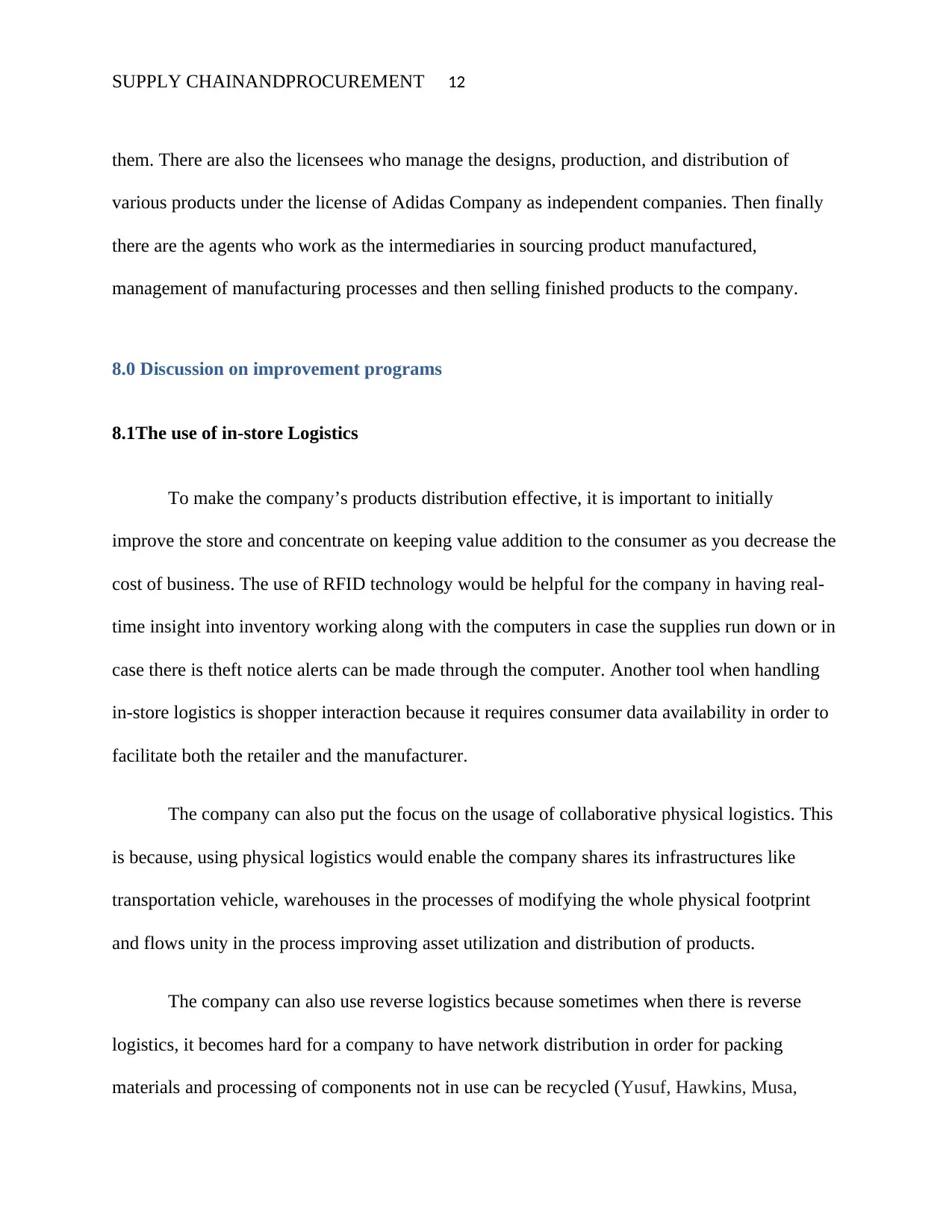
SUPPLY CHAINANDPROCUREMENT 12
them. There are also the licensees who manage the designs, production, and distribution of
various products under the license of Adidas Company as independent companies. Then finally
there are the agents who work as the intermediaries in sourcing product manufactured,
management of manufacturing processes and then selling finished products to the company.
8.0 Discussion on improvement programs
8.1The use of in-store Logistics
To make the company’s products distribution effective, it is important to initially
improve the store and concentrate on keeping value addition to the consumer as you decrease the
cost of business. The use of RFID technology would be helpful for the company in having real-
time insight into inventory working along with the computers in case the supplies run down or in
case there is theft notice alerts can be made through the computer. Another tool when handling
in-store logistics is shopper interaction because it requires consumer data availability in order to
facilitate both the retailer and the manufacturer.
The company can also put the focus on the usage of collaborative physical logistics. This
is because, using physical logistics would enable the company shares its infrastructures like
transportation vehicle, warehouses in the processes of modifying the whole physical footprint
and flows unity in the process improving asset utilization and distribution of products.
The company can also use reverse logistics because sometimes when there is reverse
logistics, it becomes hard for a company to have network distribution in order for packing
materials and processing of components not in use can be recycled (Yusuf, Hawkins, Musa,
them. There are also the licensees who manage the designs, production, and distribution of
various products under the license of Adidas Company as independent companies. Then finally
there are the agents who work as the intermediaries in sourcing product manufactured,
management of manufacturing processes and then selling finished products to the company.
8.0 Discussion on improvement programs
8.1The use of in-store Logistics
To make the company’s products distribution effective, it is important to initially
improve the store and concentrate on keeping value addition to the consumer as you decrease the
cost of business. The use of RFID technology would be helpful for the company in having real-
time insight into inventory working along with the computers in case the supplies run down or in
case there is theft notice alerts can be made through the computer. Another tool when handling
in-store logistics is shopper interaction because it requires consumer data availability in order to
facilitate both the retailer and the manufacturer.
The company can also put the focus on the usage of collaborative physical logistics. This
is because, using physical logistics would enable the company shares its infrastructures like
transportation vehicle, warehouses in the processes of modifying the whole physical footprint
and flows unity in the process improving asset utilization and distribution of products.
The company can also use reverse logistics because sometimes when there is reverse
logistics, it becomes hard for a company to have network distribution in order for packing
materials and processing of components not in use can be recycled (Yusuf, Hawkins, Musa,
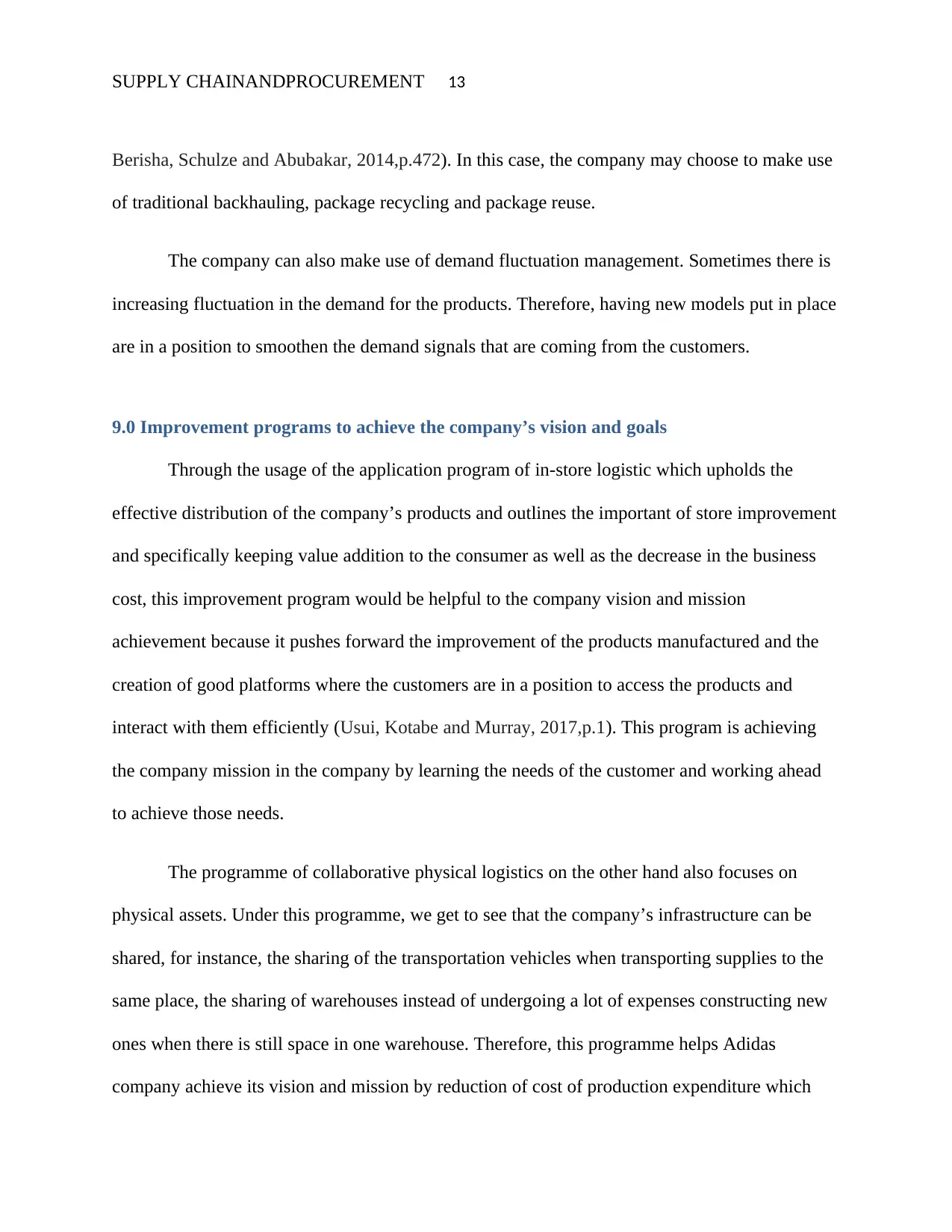
SUPPLY CHAINANDPROCUREMENT 13
Berisha, Schulze and Abubakar, 2014,p.472). In this case, the company may choose to make use
of traditional backhauling, package recycling and package reuse.
The company can also make use of demand fluctuation management. Sometimes there is
increasing fluctuation in the demand for the products. Therefore, having new models put in place
are in a position to smoothen the demand signals that are coming from the customers.
9.0 Improvement programs to achieve the company’s vision and goals
Through the usage of the application program of in-store logistic which upholds the
effective distribution of the company’s products and outlines the important of store improvement
and specifically keeping value addition to the consumer as well as the decrease in the business
cost, this improvement program would be helpful to the company vision and mission
achievement because it pushes forward the improvement of the products manufactured and the
creation of good platforms where the customers are in a position to access the products and
interact with them efficiently (Usui, Kotabe and Murray, 2017,p.1). This program is achieving
the company mission in the company by learning the needs of the customer and working ahead
to achieve those needs.
The programme of collaborative physical logistics on the other hand also focuses on
physical assets. Under this programme, we get to see that the company’s infrastructure can be
shared, for instance, the sharing of the transportation vehicles when transporting supplies to the
same place, the sharing of warehouses instead of undergoing a lot of expenses constructing new
ones when there is still space in one warehouse. Therefore, this programme helps Adidas
company achieve its vision and mission by reduction of cost of production expenditure which
Berisha, Schulze and Abubakar, 2014,p.472). In this case, the company may choose to make use
of traditional backhauling, package recycling and package reuse.
The company can also make use of demand fluctuation management. Sometimes there is
increasing fluctuation in the demand for the products. Therefore, having new models put in place
are in a position to smoothen the demand signals that are coming from the customers.
9.0 Improvement programs to achieve the company’s vision and goals
Through the usage of the application program of in-store logistic which upholds the
effective distribution of the company’s products and outlines the important of store improvement
and specifically keeping value addition to the consumer as well as the decrease in the business
cost, this improvement program would be helpful to the company vision and mission
achievement because it pushes forward the improvement of the products manufactured and the
creation of good platforms where the customers are in a position to access the products and
interact with them efficiently (Usui, Kotabe and Murray, 2017,p.1). This program is achieving
the company mission in the company by learning the needs of the customer and working ahead
to achieve those needs.
The programme of collaborative physical logistics on the other hand also focuses on
physical assets. Under this programme, we get to see that the company’s infrastructure can be
shared, for instance, the sharing of the transportation vehicles when transporting supplies to the
same place, the sharing of warehouses instead of undergoing a lot of expenses constructing new
ones when there is still space in one warehouse. Therefore, this programme helps Adidas
company achieve its vision and mission by reduction of cost of production expenditure which
Paraphrase This Document
Need a fresh take? Get an instant paraphrase of this document with our AI Paraphraser
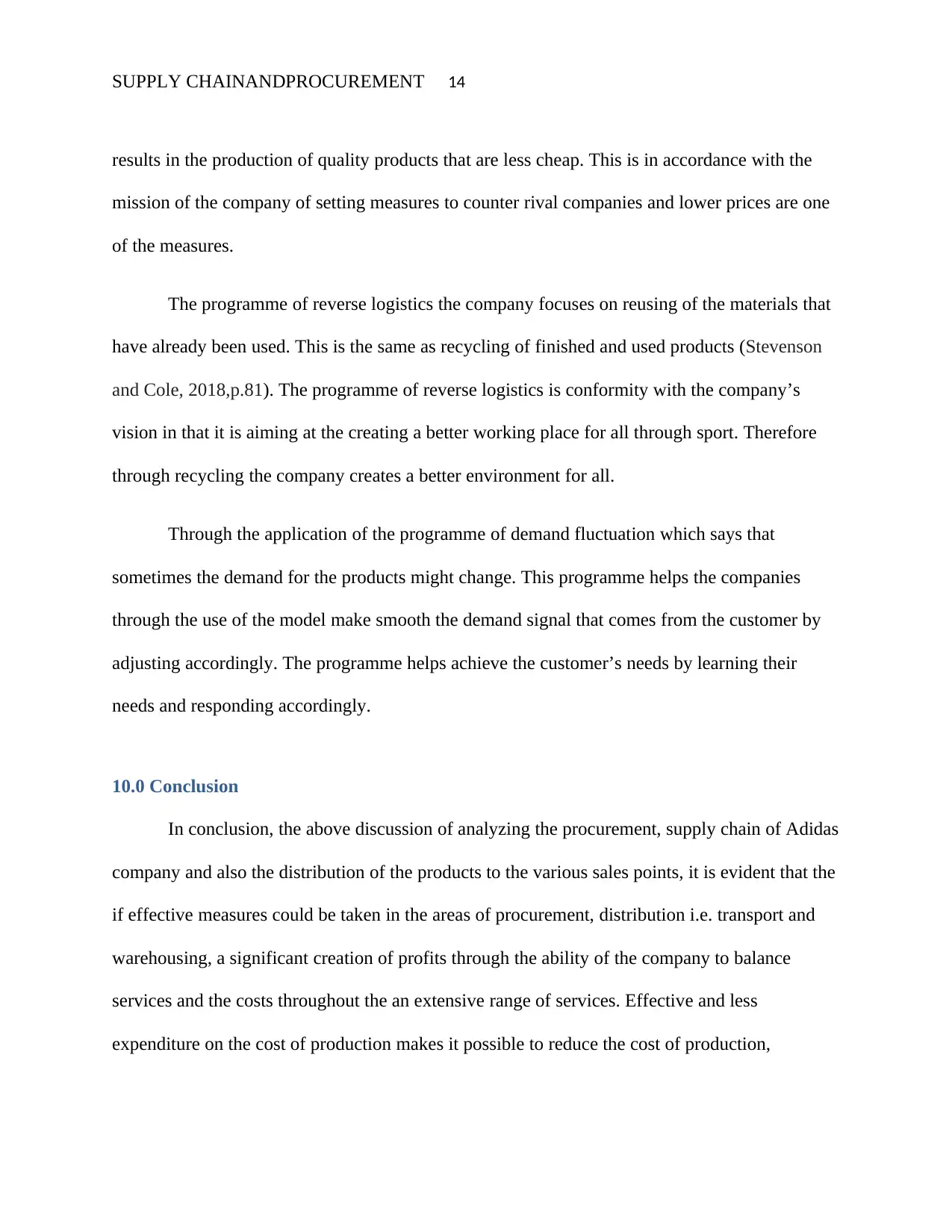
SUPPLY CHAINANDPROCUREMENT 14
results in the production of quality products that are less cheap. This is in accordance with the
mission of the company of setting measures to counter rival companies and lower prices are one
of the measures.
The programme of reverse logistics the company focuses on reusing of the materials that
have already been used. This is the same as recycling of finished and used products (Stevenson
and Cole, 2018,p.81). The programme of reverse logistics is conformity with the company’s
vision in that it is aiming at the creating a better working place for all through sport. Therefore
through recycling the company creates a better environment for all.
Through the application of the programme of demand fluctuation which says that
sometimes the demand for the products might change. This programme helps the companies
through the use of the model make smooth the demand signal that comes from the customer by
adjusting accordingly. The programme helps achieve the customer’s needs by learning their
needs and responding accordingly.
10.0 Conclusion
In conclusion, the above discussion of analyzing the procurement, supply chain of Adidas
company and also the distribution of the products to the various sales points, it is evident that the
if effective measures could be taken in the areas of procurement, distribution i.e. transport and
warehousing, a significant creation of profits through the ability of the company to balance
services and the costs throughout the an extensive range of services. Effective and less
expenditure on the cost of production makes it possible to reduce the cost of production,
results in the production of quality products that are less cheap. This is in accordance with the
mission of the company of setting measures to counter rival companies and lower prices are one
of the measures.
The programme of reverse logistics the company focuses on reusing of the materials that
have already been used. This is the same as recycling of finished and used products (Stevenson
and Cole, 2018,p.81). The programme of reverse logistics is conformity with the company’s
vision in that it is aiming at the creating a better working place for all through sport. Therefore
through recycling the company creates a better environment for all.
Through the application of the programme of demand fluctuation which says that
sometimes the demand for the products might change. This programme helps the companies
through the use of the model make smooth the demand signal that comes from the customer by
adjusting accordingly. The programme helps achieve the customer’s needs by learning their
needs and responding accordingly.
10.0 Conclusion
In conclusion, the above discussion of analyzing the procurement, supply chain of Adidas
company and also the distribution of the products to the various sales points, it is evident that the
if effective measures could be taken in the areas of procurement, distribution i.e. transport and
warehousing, a significant creation of profits through the ability of the company to balance
services and the costs throughout the an extensive range of services. Effective and less
expenditure on the cost of production makes it possible to reduce the cost of production,
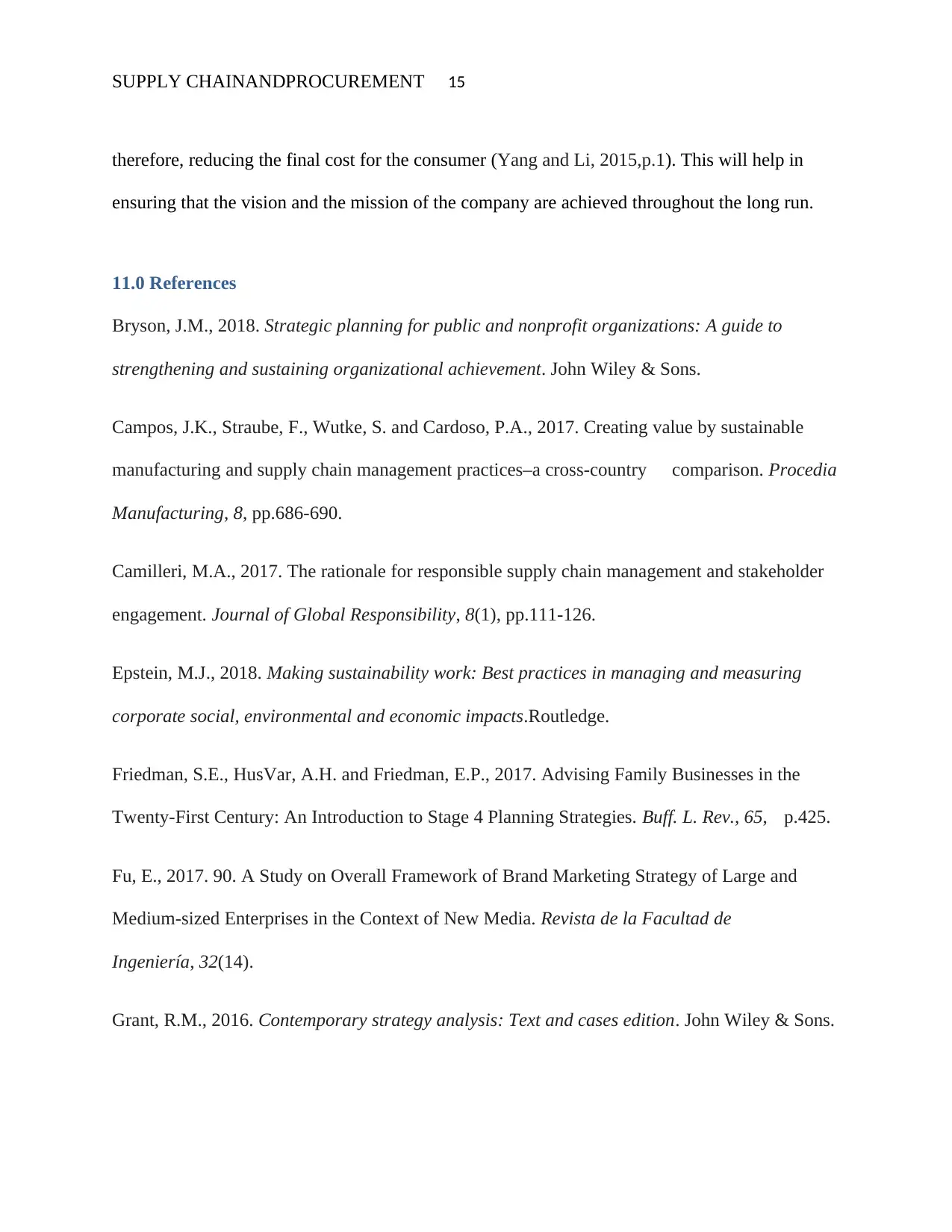
SUPPLY CHAINANDPROCUREMENT 15
therefore, reducing the final cost for the consumer (Yang and Li, 2015,p.1). This will help in
ensuring that the vision and the mission of the company are achieved throughout the long run.
11.0 References
Bryson, J.M., 2018. Strategic planning for public and nonprofit organizations: A guide to
strengthening and sustaining organizational achievement. John Wiley & Sons.
Campos, J.K., Straube, F., Wutke, S. and Cardoso, P.A., 2017. Creating value by sustainable
manufacturing and supply chain management practices–a cross-country comparison. Procedia
Manufacturing, 8, pp.686-690.
Camilleri, M.A., 2017. The rationale for responsible supply chain management and stakeholder
engagement. Journal of Global Responsibility, 8(1), pp.111-126.
Epstein, M.J., 2018. Making sustainability work: Best practices in managing and measuring
corporate social, environmental and economic impacts.Routledge.
Friedman, S.E., HusVar, A.H. and Friedman, E.P., 2017. Advising Family Businesses in the
Twenty-First Century: An Introduction to Stage 4 Planning Strategies. Buff. L. Rev., 65, p.425.
Fu, E., 2017. 90. A Study on Overall Framework of Brand Marketing Strategy of Large and
Medium-sized Enterprises in the Context of New Media. Revista de la Facultad de
Ingeniería, 32(14).
Grant, R.M., 2016. Contemporary strategy analysis: Text and cases edition. John Wiley & Sons.
therefore, reducing the final cost for the consumer (Yang and Li, 2015,p.1). This will help in
ensuring that the vision and the mission of the company are achieved throughout the long run.
11.0 References
Bryson, J.M., 2018. Strategic planning for public and nonprofit organizations: A guide to
strengthening and sustaining organizational achievement. John Wiley & Sons.
Campos, J.K., Straube, F., Wutke, S. and Cardoso, P.A., 2017. Creating value by sustainable
manufacturing and supply chain management practices–a cross-country comparison. Procedia
Manufacturing, 8, pp.686-690.
Camilleri, M.A., 2017. The rationale for responsible supply chain management and stakeholder
engagement. Journal of Global Responsibility, 8(1), pp.111-126.
Epstein, M.J., 2018. Making sustainability work: Best practices in managing and measuring
corporate social, environmental and economic impacts.Routledge.
Friedman, S.E., HusVar, A.H. and Friedman, E.P., 2017. Advising Family Businesses in the
Twenty-First Century: An Introduction to Stage 4 Planning Strategies. Buff. L. Rev., 65, p.425.
Fu, E., 2017. 90. A Study on Overall Framework of Brand Marketing Strategy of Large and
Medium-sized Enterprises in the Context of New Media. Revista de la Facultad de
Ingeniería, 32(14).
Grant, R.M., 2016. Contemporary strategy analysis: Text and cases edition. John Wiley & Sons.
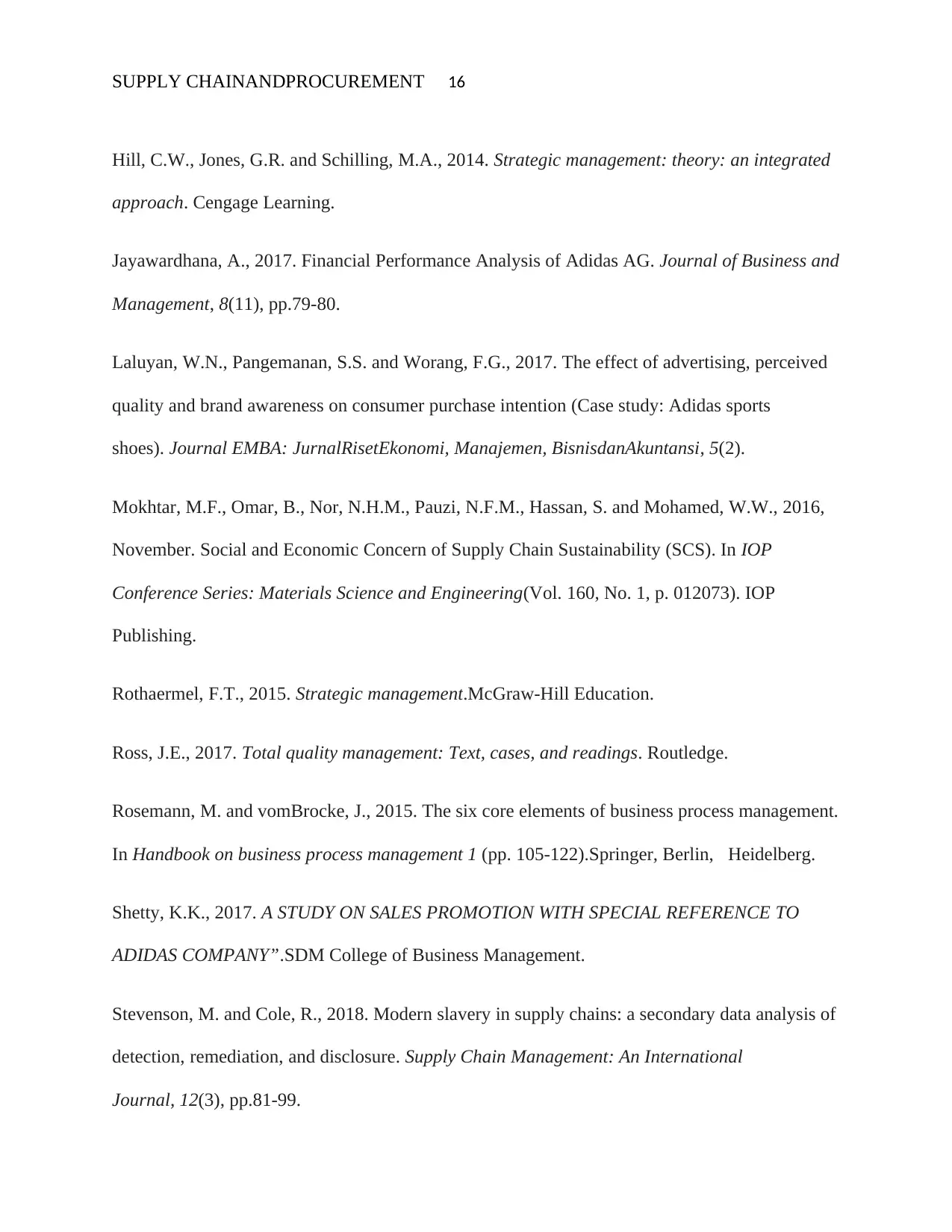
SUPPLY CHAINANDPROCUREMENT 16
Hill, C.W., Jones, G.R. and Schilling, M.A., 2014. Strategic management: theory: an integrated
approach. Cengage Learning.
Jayawardhana, A., 2017. Financial Performance Analysis of Adidas AG. Journal of Business and
Management, 8(11), pp.79-80.
Laluyan, W.N., Pangemanan, S.S. and Worang, F.G., 2017. The effect of advertising, perceived
quality and brand awareness on consumer purchase intention (Case study: Adidas sports
shoes). Journal EMBA: JurnalRisetEkonomi, Manajemen, BisnisdanAkuntansi, 5(2).
Mokhtar, M.F., Omar, B., Nor, N.H.M., Pauzi, N.F.M., Hassan, S. and Mohamed, W.W., 2016,
November. Social and Economic Concern of Supply Chain Sustainability (SCS). In IOP
Conference Series: Materials Science and Engineering(Vol. 160, No. 1, p. 012073). IOP
Publishing.
Rothaermel, F.T., 2015. Strategic management.McGraw-Hill Education.
Ross, J.E., 2017. Total quality management: Text, cases, and readings. Routledge.
Rosemann, M. and vomBrocke, J., 2015. The six core elements of business process management.
In Handbook on business process management 1 (pp. 105-122).Springer, Berlin, Heidelberg.
Shetty, K.K., 2017. A STUDY ON SALES PROMOTION WITH SPECIAL REFERENCE TO
ADIDAS COMPANY”.SDM College of Business Management.
Stevenson, M. and Cole, R., 2018. Modern slavery in supply chains: a secondary data analysis of
detection, remediation, and disclosure. Supply Chain Management: An International
Journal, 12(3), pp.81-99.
Hill, C.W., Jones, G.R. and Schilling, M.A., 2014. Strategic management: theory: an integrated
approach. Cengage Learning.
Jayawardhana, A., 2017. Financial Performance Analysis of Adidas AG. Journal of Business and
Management, 8(11), pp.79-80.
Laluyan, W.N., Pangemanan, S.S. and Worang, F.G., 2017. The effect of advertising, perceived
quality and brand awareness on consumer purchase intention (Case study: Adidas sports
shoes). Journal EMBA: JurnalRisetEkonomi, Manajemen, BisnisdanAkuntansi, 5(2).
Mokhtar, M.F., Omar, B., Nor, N.H.M., Pauzi, N.F.M., Hassan, S. and Mohamed, W.W., 2016,
November. Social and Economic Concern of Supply Chain Sustainability (SCS). In IOP
Conference Series: Materials Science and Engineering(Vol. 160, No. 1, p. 012073). IOP
Publishing.
Rothaermel, F.T., 2015. Strategic management.McGraw-Hill Education.
Ross, J.E., 2017. Total quality management: Text, cases, and readings. Routledge.
Rosemann, M. and vomBrocke, J., 2015. The six core elements of business process management.
In Handbook on business process management 1 (pp. 105-122).Springer, Berlin, Heidelberg.
Shetty, K.K., 2017. A STUDY ON SALES PROMOTION WITH SPECIAL REFERENCE TO
ADIDAS COMPANY”.SDM College of Business Management.
Stevenson, M. and Cole, R., 2018. Modern slavery in supply chains: a secondary data analysis of
detection, remediation, and disclosure. Supply Chain Management: An International
Journal, 12(3), pp.81-99.
Secure Best Marks with AI Grader
Need help grading? Try our AI Grader for instant feedback on your assignments.
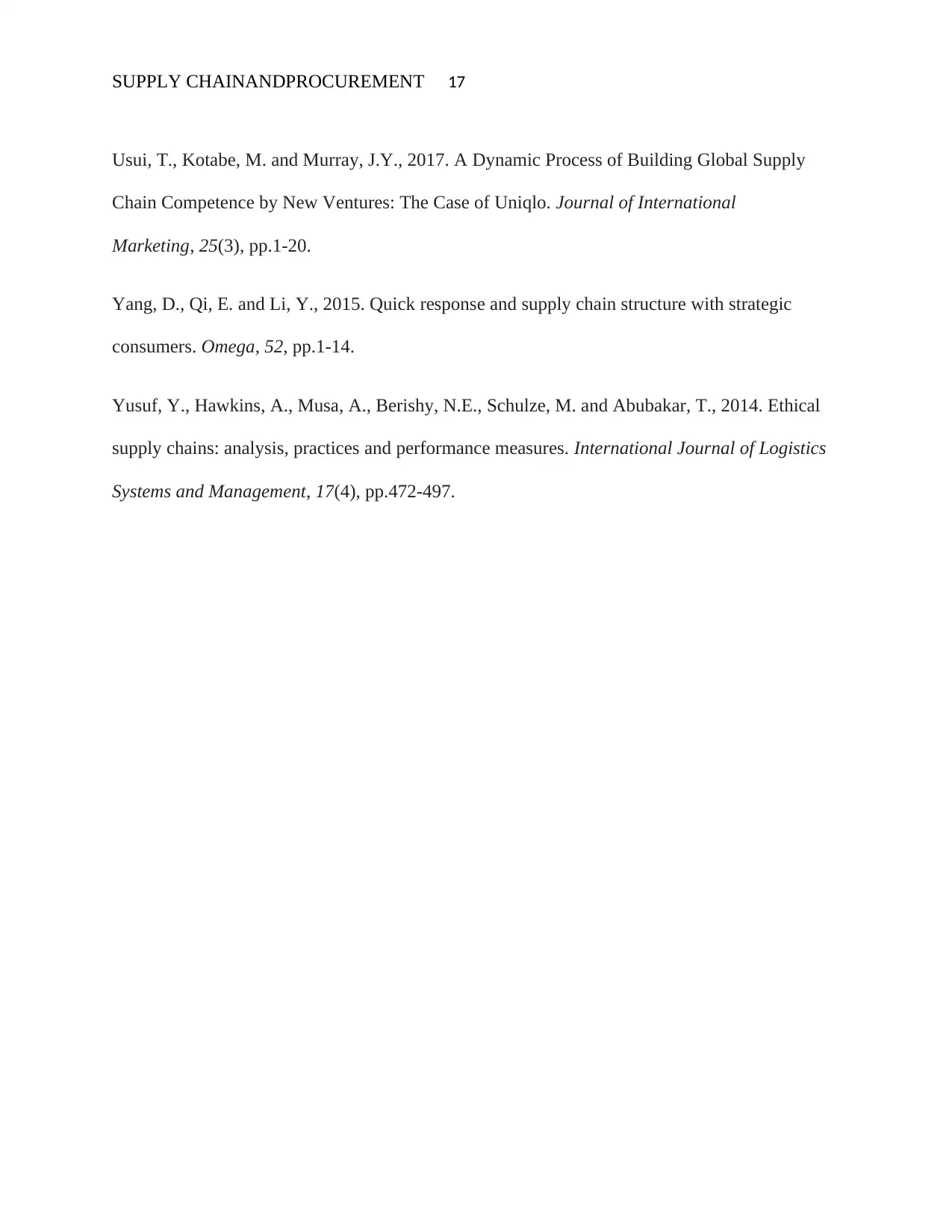
SUPPLY CHAINANDPROCUREMENT 17
Usui, T., Kotabe, M. and Murray, J.Y., 2017. A Dynamic Process of Building Global Supply
Chain Competence by New Ventures: The Case of Uniqlo. Journal of International
Marketing, 25(3), pp.1-20.
Yang, D., Qi, E. and Li, Y., 2015. Quick response and supply chain structure with strategic
consumers. Omega, 52, pp.1-14.
Yusuf, Y., Hawkins, A., Musa, A., Berishy, N.E., Schulze, M. and Abubakar, T., 2014. Ethical
supply chains: analysis, practices and performance measures. International Journal of Logistics
Systems and Management, 17(4), pp.472-497.
Usui, T., Kotabe, M. and Murray, J.Y., 2017. A Dynamic Process of Building Global Supply
Chain Competence by New Ventures: The Case of Uniqlo. Journal of International
Marketing, 25(3), pp.1-20.
Yang, D., Qi, E. and Li, Y., 2015. Quick response and supply chain structure with strategic
consumers. Omega, 52, pp.1-14.
Yusuf, Y., Hawkins, A., Musa, A., Berishy, N.E., Schulze, M. and Abubakar, T., 2014. Ethical
supply chains: analysis, practices and performance measures. International Journal of Logistics
Systems and Management, 17(4), pp.472-497.
1 out of 17
Related Documents
Your All-in-One AI-Powered Toolkit for Academic Success.
+13062052269
info@desklib.com
Available 24*7 on WhatsApp / Email
![[object Object]](/_next/static/media/star-bottom.7253800d.svg)
Unlock your academic potential
© 2024 | Zucol Services PVT LTD | All rights reserved.




